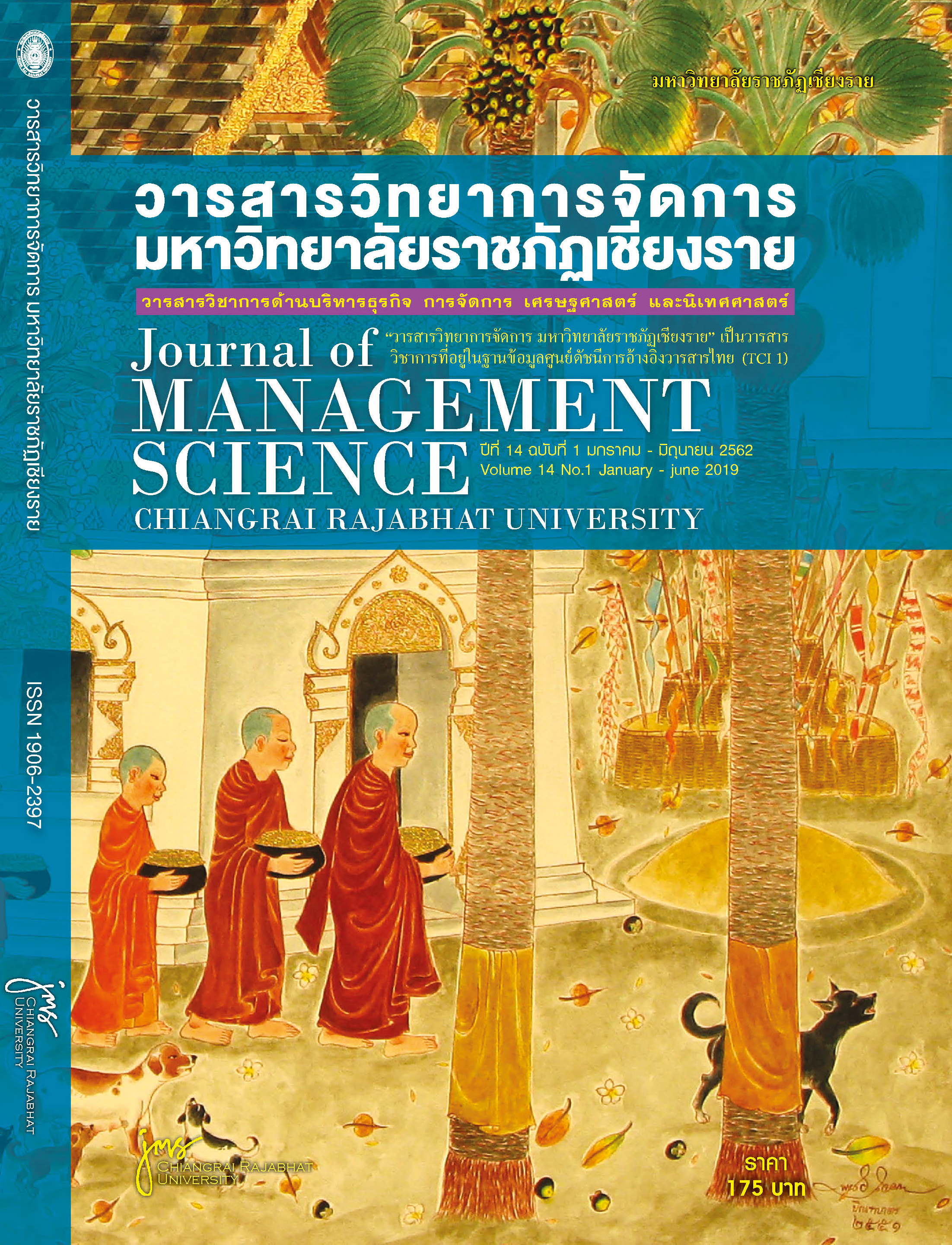The Development of Tourism Logistics Connectivity on Luangprabang-Indochina-Myanmar Route
Main Article Content
Abstract
The Luangprabang-Indochina-Mawlamyine Route (LIMR) is a new strategic road being developed to stimulate cooperation between three countries in the economic, social and cultural development. A connection point is a border trade, investment including the sharing of cultural well-being and resources. In addition, also promotes and connects economic growth to economic development of each area. The purpose of this research aims to study tourism resources, infrastructure, routes, rules and regulations in Lower Northern Provincial Cluster 1 of Thailand (Phitsanulok, Uttaradit, Tak, Sukhothai and Phetchabun), Luangprabang Province in northern Laos PDR, Kayin and Mon State in Myanmar. The development of tourism routes the accessibility of tourist attractions, internet database systems, the establishment of landmarks that are linked to local communities and security systems, the tourism activity network, the printed media, advertisements and communication, as well as the assessment of tourists’ satisfaction towards the project through questionnaire and to evaluate the results after the implementations of the project or sub-activities. For the LIMR route were found that the potential of infrastructure, facilities and tourism services are likely to have adequate capacity to accommodate both quantitative and qualitative tourism. In short, the destinations to which it is easy to travel may not be good but the environmental impact of transport is suitable for travel especially ecotourism. In conclusion, concerning the strategy and policy suggestions for the development of the tourism route, the major concern is to provide and manage infrastructures such as roads, water supply, electricity, garbage management, parking area, telecommunication system, accommodations, restaurants and souvenir shops in order to support the tourists. Moreover, there must be the control over the number of tourists in the area, as well as other issues and effects from the development of the tourism in the area. There must also be meetings held for publicizing the findings from the research.
Article Details
Views and opinions expressed in the journal do not necessarily reflect those of the editors.
References
Chairatana, P. & ThalangPotential, C.N. (2017). Potential of tourism resources in Udon Thani Province. Dusit College Journal. 11(2), 124-142.
Chantub, R. & Pocharee, L. (2016). Tourism identity factors affecting the success of tourism management in Chang Ta Kang village, Surin Province. WMS Journal of Management, 5(1), 48-59.
Hunter, C. (1997). Sustainable tourism as an adaptive paradigm. Annals of Tourism Research, 24, 850-867.
Immigration Bureau (2018). Border crossing data provide summary statistics for inbound and outbound crossings at the Thailand. Retrieved December 12, 2018, from Web site: https://www.immigration.go.th/index.
Inskeep, E. (1999). Tourism Planning: An integrated and sustainable development approach. New York: Van Nostrand Reinhold.
Mowforth, M. & Munt, I. (2003). Tourism and sustainability: Development and new tourism in the third world. London: Routledge.
Naidoo, P., Ramseook-Munhurrun, P. & Seegoolam, P. (2011). An assessment of visitor satisfaction with nature-based tourism attractions. International Journal of Management and Marketing Research. 4(1), 87-98.
Nutalai, J., Seniseth, M., Poungchaey, H., Loud Sa-Ard B., Numjalernsombat, V. (2009). Research project on empowerment evaluation for enhancing people's mobilization on the ground (Phrase I). The Thailand Research Fund. 349 p.
Office of the National Economics and Social Development Council. (2012). The direction of northern provincial cluster development. Retrieved October 8, 2016, from Web site: https://eris.nesdb.go.th/pdf/401003-002.pdf.
Pimonsompong, C. (2003). Tourism planning and marketing development. Bangkok: Kasetsart University Press.
Porter, M.E. (1985). Competitive Advantage. Creating and Sustaining Superior Performance. Free Press, New York, 557 p.
Priskin, J. (2001). Assessment of natural resources for nature-based tourism: the case of the Central Coast Region of Western Australia. Tourism Management. 22, 637-648.
Rea, L.M. & Parker, R.A. (1997). Designing and conducting survey research: A Comprehensive Guide. Jossey-Bass: New York.
Swarbrooke, J. (1999). Sustainable tourism management. Oxford: CABI Publishing.
Walter, J. & Noble, A. (2000). A manual for sustainable tourism destination management. Asian Institute of Technology. Bangkok: Saengsawang.

